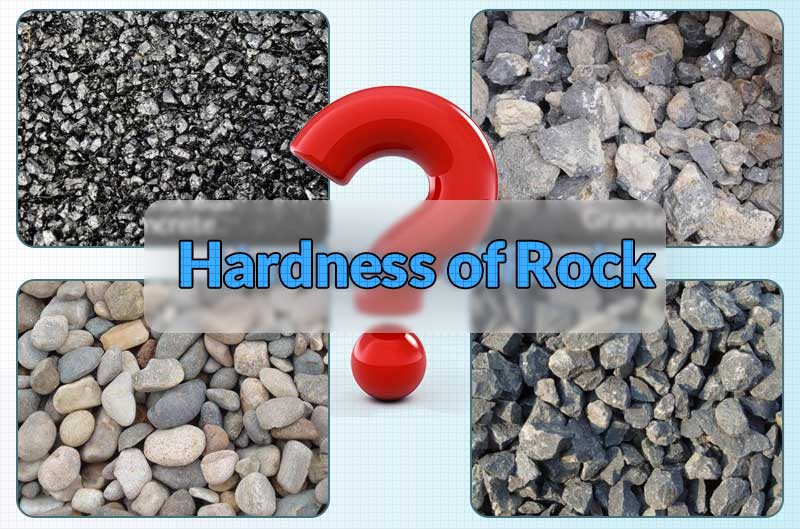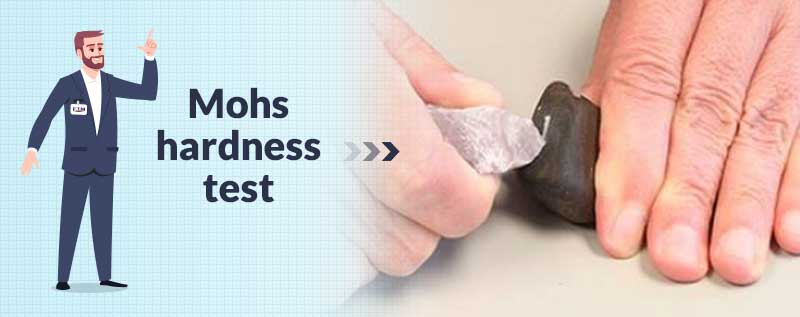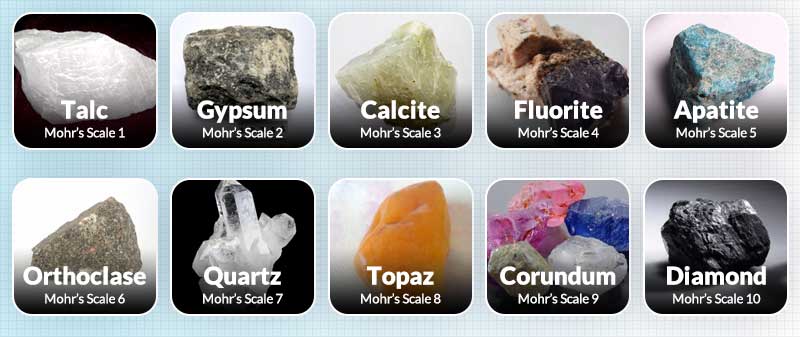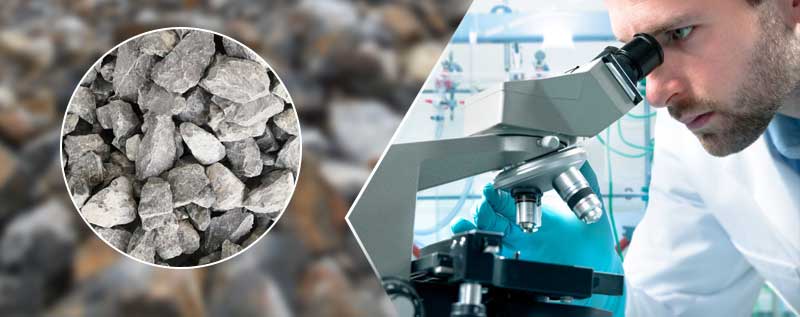If you want to produce large quantities of high-quality materials, you need to carefully analyze the hardness of your hard rock. Different rock hardness is configured with different rock crusher.
What is rock hardness?
Rock hardness refers to the resistance of a rock to scratching. Its value equals the uniaxial compressive strength (MPa) of the rock divided by 10.

Rock hardness and compressive strength have a certain connection, but also have big differences. Rock hardness is the resistance of a part of the rock surface when it is pressed into another object. Compressive strength is the resistance when the rock is crushed as a whole. Therefore, the uniaxial compressive strength of rock is not the index of rock hardness.
According to theoretical analysis, rock hardness is (1+ 2 m) times bigger than its uniaxial compressive strength. Many experiments show that the ratio of rock hardness to uniaxial compressive strength is about 5-20 times. The rock hardness index is closer to the ease of drilling into the rock fragment.
How to measure rock hardness?
A variety of rock hardness scale tests are available. They include the Mohs hardness scale, Protodyakonov scale, Brinell scale, Rockwell scale, Vickers hardness test, Leeb hardness test, etc.
Generally, hard metal rock adopts the Brinell scale, Rockwell scale, Vickers and Leeb hardness test. Plastic materials adopt the Barcol and Shore test. Rubber adopts the Shore test. For the hard rock, it adopts Mohs hardness scale and Protodyakonov scale.
1. Mohs hardness scale
Mohs hardness scale is a standard for measuring rock hardness. It uses a diamond drill to scratch the surface of tested rocks. The depth of scratch is the Mohs hardness scale.

According to the notch depth of 10 minerals, Mohs hardness scale is divided into 10 levels: diamond (10), corundum (9), topaz (8), quartz (7), orthoclase (6), apatite (5), fluorite (4), calcite (3), gypsum (2), talc (1).
These 10 levels show the order of rock hardness, not the degree of rock hardness. The front rock can scratch the rock that ranks behind it. Diamond mohs scale is 10 and it is the hardest stone. Mohs hardness scale is a purely ordinal scale. For example,corundum (9) is twice as hard as Topaz (8), but diamond (10) is four times as hard as corundum.

Common hard rocks hardness:
garnet hardness: 6.5-7.5
sapphire hardness: 9
topaz hardness: 8
emerald hardness: 7.5-8
hematite hardness: 5.5-6.5
tourmaline hardness: 7-8
ruby hardness: 9
opal hardness: 5-5.5
aquamarine hardness: 7.5-8
morganite hardness: 7.5-8
moonstone hardness: 6-6.5
tanzanite hardness: 6-7
sapphire mohs scale: 9
alexandrite hardness: 8-8.5
amethyst mohs scale: 7
agate hardness: 6.5-7
When working in the wild, how do you quickly measure the hardness of a hard rock?
First, break the hard rock. Then use your fingernail (Mohr’s Scale 2), copper keys (Mohr’s Scale 3) and a small knife (Mohr’s Scale 5.5) to scratch the cutting section of the hard rock. If your nail has the notch, the rock is harder than the nail. If the key has the notch, the rock hardness is larger. If the knife is carved, the rock is very strong.
By adopting Mohs hardness scale, you can quickly measure the hardness of unknown hard rock. This method is rough but convenient, inexpensive and easy to understand. Therefore, it has been widely used worldwide for more than 200 years.
2. Protodyakonov scale
Protodyakonov scale uses rock hardness to indicate the ease of rock breaking. This method is conducted in the laboratory. It is scientific and reasonable but has certain measurement errors.
Protodyakonov scale has a formula. f = R/10. The f-value is used for estimating the scratch resistance of rock and its stability after drilling. The R-value refers to the uniaxial compressive strength of rock in MPa.

Protodyakonov scale includes 10 levels. The higher the level of rock, the easier it is to crush. A half level is added between Level III and Level IV, Level V and Level VI as well as Level VII and Level VIII for convenience.
| Level | Firmness | Typical rocks |
| I | The strongest | Quartz, basalt. (f=20) 200MPa |
| II | Very strong | Very strong granite rocks, quartz porphyry, very strong slate, less strong than the above quartzites, the strongest sandstones and limestones. (f=15) 150MPa |
| III | Strong | Granite (dense) and granite rocks, very strong sandstones and limestones, quartz ore veins, strong conglomerate, very strong iron ore. (f=10) 100MPa |
| IIIa | Strong | Limestones (strong), weak granite, strong sandstones, strong marble, dolomite, pyrite.(f=8)80MPa |
| IV | Pretty soft | Common sandstone, Iron ore.(f=6)60MPa |
| IVa | Pretty soft | Sandy schists, shale sandstones.(f=5)50MPa |
| V | Medium strength | Strong clay slate, loose sandstone and limestone, soft conglomerate.(f=4)40MPa |
| Va | Medium strength | A variety of shales (non-strong), dense marl.(f=3) 30MPa |
| VI | Pretty soft | Soft slate, very soft limestone, chalk, rock salt, gypsum, frozen soil, anthracite, common marl, destroyed sandstone, cemented pebbles.(f=2)20MPa |
| VIa | Pretty soft | Crushed stone soil, destroyed slate, caked slate, caked pebbles, rubble, hard coal, hardened clay.(f=1.5)15MPa |
| VII | Soft | Clay (dense), soft coal, strong sediment, clay soil.(f=1) |
| VIIa | Soft | Light sandy clay, loess, gravel.(f=0.8)8MPa |
| VIII | Earthy rocks | Plant land, peat, light loam, raw sand.(f=0.6)6MPa |
| IX | Loose sands | Sand, scree, fine gravel, bulk earth, mined coal.(f=0.5)5MPa |
| X | Rock float | Quicksand, swampy soil, liquefied loess and other liquefied rocks, soils.(f=0.3)3MPa |
Protodyakonov rock classification is based on Protodyakonov scale to classify the hard rock and soft rock.
- f = 15-20: Extremely strong rocks, such as very strong granite, limestone, quartzite, etc.
- f = 8-10: Strong rocks, such as strong granite, strong sandstone, etc.
- f = 4-6: Medium strength rocks, such as common sandstone, iron ore, etc.
- f = 0.8-3: Soft rocks, such as swampy soil (only 0.3).
Common rocks hardness:
- Granite: 10-25
- Gabbro, rhyolite: 18-30
- Andesite, marble and diorite: 10-25
- Diabase: 20-35
- Basalt: 15-30
- Quartzite: 15-35
- Gneiss: 5-20
- Phyllite, schist, shale: 1-10
- Slate: 6-20
- Sandstone: 2-20
- Conglomerate: 1-15
- Limestone: 5-20
- Dolomites: 8-25
Protodyakonov scale is the test result of slightly weathered or unweathered fresh rocks. Due to the complicated characteristics of rock genesis and structure, rock hardness may vary greatly.
How to classify the rocks?
According to the rock hardness, it can be divided into hard rock, soft rock and extremely soft rock. Hard rock includes very strong rock and strong rock; soft rock includes pretty soft rock and soft rock.
1. Hard rock
Hard rock refers to a strong rock with a uniaxial compressive strength greater than 30MPa. It includes granite, basalt, river pebble, quartzite, tuff, diabase, gneiss, etc. A hard rock has a high compressive strength, low water absorption, good chemical stability and strong durability. Therefore, hard rock is a high-quality building material that sells well in the market.In production, we most often crush the hard rock.
2. Soft rock
Soft rock has a low uniaxial compressive strength of less than 30MPa. It mainly includes phyllite, schist, mudstone, slate, tuff, and marble rock.
3. Extremely soft rock
Extremely soft rock has a very low uniaxial compressive strength less than 5MPa, and the softening coefficient is greater than 1.0. It is mainly composed of clay, carbonaceous, sericite and hydromica.
Hard rock crushing
1. Granite
Granite, which is formed by igneous rock, is a lenticular hard rock with a carbon dioxide content of more than 70%. It is mainly composed of quartz, feldspar, a small amount of biotite and other dark minerals. Granite is a strong and dense building material with high compressive strength, low water absorption and good wear resistance.

Rock hardness: Mohr's Scale 6-7
Granite Crushers: Jaw crusher, impact crusher(or cone crusher)and sand maker.
Crushing process:
- 1Coarse crushing and fine crushing: Granite is evenly sent to a jaw crusher through a vibrating feeder for coarse crushing, then sent to an impact crusher or cone crusher through a belt conveyor for fine crushing;
- 2Fine crushing and shaping: The materials are screened by a vibrating screen, then sent to a sand maker for fine crushing and shaping. Qualified materials are sent to the sand washer, while the others continue to be finely ground.
- 3Washing: Materials are washed by a sand washer as the final product.
2. Basalt
Basalt is a a hard rock with high silicon content and high abrasiveness. In actual crushing, it is quite difficult to be crushed and costs a lot.

Rock hardness: Mohr's Scale 5-7
Basalt Crushers: Jaw crusher, cone crusher and impact crusher.
Crushing process:
It uses the principle of laminated crushing to reduce the loss of wear-resistant parts.
- 1Coarse crushing: Basalt is sent to a jaw crusher through a vibrating feeder for coarse crushing;
- 2Secondary crushing: Then the hardrocks are sent to a cone crusher through a belt conveyor for secondary crushing;
- 3Fine crushing and shaping: Next, the hard rocks are sent to an impact crusher or shaping crusher;
- 4Screening: Finally, the fine materials are screened by a vibrating screen. Qualified materials are sent to a storage bin, while the others continue to be finely crushed;
- 5Dust removal: Use a dry dust collector. Whether to use the dust collector depends on the cleanliness of materials. Check the mud content and whether there is a washing process. If there is a washing process, no dust collector is needed.
3. River pebble
River pebble is a is a kind of hard stone that is formed naturally after long-term river water impact, squeeze, and friction. It is strong, not easy to corrode and weather. To reduce the loss of wear parts such as jaws, hammers, and impact plates, the crushing of river pebble is based on the principle of laminated crushing.

Rock hardness: Mohr's Scale 7
River pebble Crushers: Jaw crusher, cone crusher, impact crusher or sand maker.
Crushing process:
- 1Coarse crushing: River pebble is first sent to a jaw crusher through a vibrating feeder for primary crushing;
- 2Fine crushing: The materials are sent to a cone crusher for secondary crushing;
- 3Sand making and shaping: The finely ground materials enter an impact crusher or a sand maker for the third crushing;
- 4Washing: Qualified materials are washed by a sand washer as final product, while the others return to the third crushing process.
4. Andesite
Andesite is a kind of volcanic rock, named after its abundance in the Andes of America. The phenocrysts are mainly plagioclase and dark minerals. The dark minerals are composed of biotite, hornblende and pyroxene. Andesite has a stomatal and massive structure. Some stomata are filled with calcite, quartz, chlorite and other minerals to form an amygdaloidal structure.

Rock hardness: Mohr's Scale 1.5
River pebble Crushers: A jaw crusher, cone crusher and sand maker.
Crushing process:
- 1Coarse crushing: Andesite is sent to a jaw crusher through a vibrating feeder for primary crushing;
- 2Secondary crushing: Then the materials are sent to a cone crusher for secondary crushing;
- 3Fine crushing and shaping: After the screening by a circular vibrating screen, the medium-grained materials are sent to a sand maker for fine crushing and shaping, while the others return to the cone crusher;
- 4Washing: Qualified materials are washed by a sand washer as the final product.
5. Limestone
Limestone is a kind of medium-strength rock and its main component is calcium carbonate. After processing, stone and caustic lime can be directly obtained. The caustic lime can be turned into hydrated lime after adding some water.

Rock hardness: Mohr's Scale 3.5-4
Limestone crushers: Crushing process one uses a heavy hammer crusher. Crushing process two uses a jaw crusher, impact crusher and sand maker.
Crushing process:
Due to the unfixed size of raw materials and different requirements, two crushing processes are recommended.
Crushing process one
Just use one PCZ heavy hammer crusher as the main crushing force to crush limestone at one time. The feeding port of machine is large and its cost is low. However, the hammer head and grate screen need to be replaced regularly in case they wear out quickly.
Crushing process two
In order to reduce the loss of wear-resistant parts and obtain more uniform finished materials, two-stage crushing and shaping are adopted.
- 1Coarse crushing and fine crushing: Limestone is sent to a jaw crusher for coarse crushing, then sent to an impact crusher for further crushing;
- 2Screening and shaping: The crushed materials are screened by a vibrating screen. The materials that meet the requirements of particle size are sent to a sand washer, while the others return to the cone crusher;
- 3Washing: Qualified materials are washed by a sand washer. After washing, they are sent to the material pile through a conveyor.
6. Quartz
Quartz is a new type of hard stone artificially synthesized by quartz crystals(more than 90%), resin and other trace elements. The higher the quartz content, the better the quality. High-quality quartz is not easy to deform. It is a kind of reusable and environmentally friendly building material without any radioactive pollution.

Rock hardness: Mohr's Scale 7
Limestone crushers: Crushing process one uses a jaw crusher, cone crusher and impact crusher (or sand maker). Crushing process two uses a heavy hammer crusher. Crushing process three uses a roller crusher.
Crushing process:
Crushing process one
- 1Coarse crushing: Quartz is sent to a jaw crusher through a vibrating feeder for primary crushing;
- 2Secondary crushing: Then the materials are sent to a cone crusher for secondary crushing;
- 3Fine crushing and shaping: After screening, materials are sent to an impact crusher or sand maker for fine crushing and shaping;
- 4Washing: Qualified materials are washed by a sand washer as the final product.
Crushing process two
This process only uses a heavy hammer crusher, because it has a good effect of one-time crushing and shaping of quartz stone.
Crushing process three
Use a roller crusher to crush the quartz. Customers can adjust the distance between the two rollers to realize the required particle size and have a good effect of crushing and sand making effect.
7. Asphalt concrete
Asphalt concrete is a kind of coarse aggregate gap-graded asphalt concrete. It uses coarse hard rocks to form the framework. Bitumastic fills the voids in the framework and glue them together. Asphalt concrete is composed of coarse aggregate (69%~78%), mineral powder (6%~10%), and oilstone (about 5%).

Asphalt concrete crushers: Crushing process one uses a jaw crusher. Crushing process two uses a hammer crusher. Crushing process three uses a single-cylinder cone crusher.
Crushing process:
Asphalt concrete has three crushing processes. The selection of crushers should be based on the customer’s needs and actual conditions.
Crushing process one
The jaw crusher has a large crushing ratio, small volume and reasonable structure. For the crushing effect, the jaw crusher has a deep crushing cavity, which can coarsely crush the asphalt concrete through extrusion.
Crushing process two
A hammer crusher can crush and shape asphalt concrete at one time. This crusher has high sealing to effectively reduce dust pollution. The hammer head is wear-resistant. The finished product is uniform and the entire crushing site is clean and neat.
Crushing process three
The single-cylinder cone crusher adopts the principle of laminated crushing to crush the material uniform. This crusher has a high degree of automation and can be operated remotely. It also has less dust, thus it can greatly improve the work efficiency.
8. Gold ore
Gold ore is a metal ore with high rock hardness. It can be directly used as an important metallic raw material or building material. Due to the extremely low content of gold in the ore, it is necessary to separate the gold by crushing, grinding and extracting.

Gold ore crushers: A jaw crusher and a cone crusher (single-cylinder or multi-cylinder hydraulic cone crusher).
Crushing process:
The crushing of gold ores often adopts two-stage crushing: jaw crusher and cone crusher (single-cylinder or multi-cylinder hydraulic cone crusher).
- 1Coarse crushing: Firstly, the gold ore is sent to a jaw crusher by the vibrating feeder for primary crushing;
- 2Fine crushing: Then the materials are sent to a cone crusher through the conveyor for secondary crushing.

